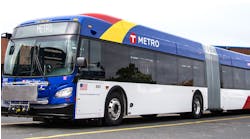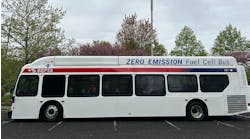With ridership on Norman’s city/university bus system increasing year after year, CART has announced plans to expand services. Part of that expansion includes longer hours, a new high-usage bus stop and free fare for paratransit passengers on fixed-route buses.
New services take effect on Jan. 12, said Doug Myers, director of OU Parking and Transportation Services, operator of CART (Cleveland Area Rapid Transit). Norman is the county seat of Cleveland County, Okla.
CART began in 1980 as a way to alleviate parking problems on the University of Oklahoma campus. It continues to serve in that capacity, along with serving the citizens of Norman on city routes and the elderly and disabled with CARTaccess, an origin-to-destination bus service.
CART boasts more than 1 million passenger rides annually on its fixed-route bus system and more than 30,000 rides annually on CARTaccess.
“Because those numbers continue to grow, CART must grow, “ Myers said. “We have looked at ways to help both the university students we serve and our aging and disabled customers.”
OU student government officials approached Myers over the fall semester about lengthening routes from 9 to 10 p.m. on campus buses. More and more classes are held in the evenings, with some dismissing at 9:20 p.m.
“Longer service hours means fewer students driving to campus and more taking the bus,” Myers said.
OU students pay a transportation fee as part of tuition and are not charged a fare for riding CART. A valid student ID card is needed to board and ride CART. Student fees will be used to pay for this extended service, Myers said. OU faculty and staff also ride fare free.
Research Route (42), offering transportation between main campus and the Research Campus, will add four hours of service in the evenings. The final run from the National Weather Center will be at 9:25 p.m., and the last run from Campus Depot near the stadium will be at 9:45 p.m. Other routes offering service until 10 p.m. on weekday evenings are:
- Main Street (10)
- Lindsey East (11)
- Lindsey West (12)
- West Norman Link (20)
- Alameda/East Norman (21)
CARTaccess also will operate until 10 p.m. in its primary zone. The service typically transports more than 120 passengers a day to doctor’s appointments, grocery shopping, etc., and has grown at a rate of 3 percent over the past six months.
“To help counter some of the stress on this system, we will offer free fare for CARTaccess-eligible riders on our fixed-route buses,” Myers said. “It is our belief that many who utilize CARTaccess will find increased independence on the buses.
“Rider training will be offered to anyone who is leery of, or wishes to learn, the fixed-route system.”
These riders will be asked to show a CARTaccess ID for free fare on the buses. The ID cards are available to any established CARTaccess rider at the CART office, 510 E. Chesapeake. Others who believe they are eligible should phone (405) 325-5438 or visit www.rideCART.com to find paperwork to apply.
CARTaccess riders considering using fixed-route buses asked for a stop at the Cleveland County Family YMCA at Halley and Lexington streets. Beginning Jan. 12, the stop at Westheimer/Halley will move to Halley/Lexington. This is Stop 192 on the Alameda/East Norman (21) route.
“The YMCA has generously agreed to share the cost for a new bus shelter and concrete pad for it to sit on,” Myers said. “CART and the YMCA expect this to become a hot stop in northeast Norman.”
Many of the increased services were made possible by an increase of $50,000 per year in city funding, Myers said. Additional services, like running buses on Sundays, will be possible with additional operations and capital funding.
In the meantime, CART is looking forward to the arrival of two new 35-foot compressed natural gas (CNG) buses later this year.
“Norman, for a city its size, is fortunate to have a public transportation system. We also are fortunate to have the support of many local, state and national leaders who understand what a lure public transit is to companies and residents looking to relocate,” Myers said.

